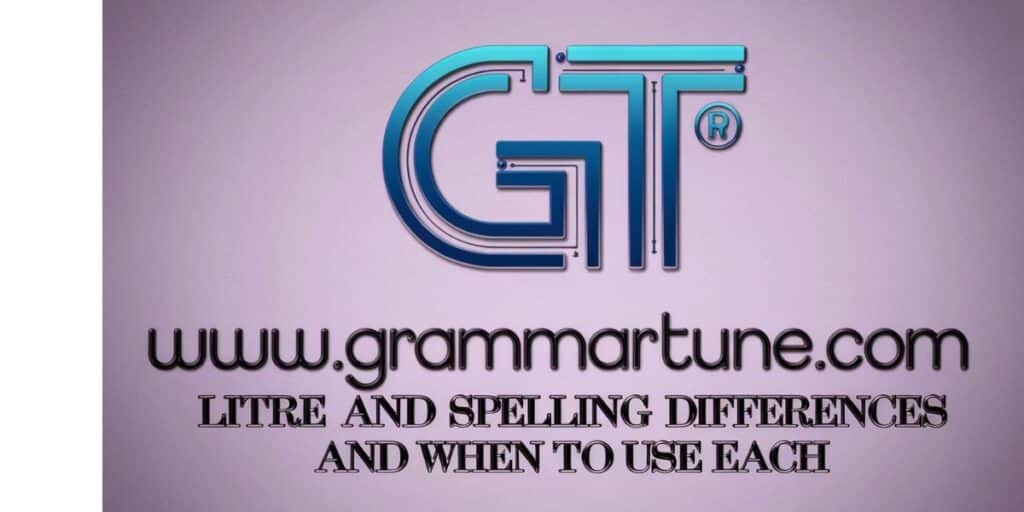Litre and Liter: two spellings, one meaning, but when should you use each? Whether you’re traveling, studying science, or just curious about international English, understanding the focus keyword can help you communicate more clearly.
While litre is the preferred spelling in countries like the United Kingdom, Australia, and Canada, liter reigns supreme in the United States. Knowing these focus keyword differences ensures you choose the right form for your audience.
Let’s dive into the history, usage rules, and easy tips to master both spellings without second-guessing yourself.
📚 Table of Contents
✨ Understanding the Basics
- 🔍 Litre vs. Liter: What’s the Difference?
- 🤔 Is It Litres or Liters?
- 🆎 Is Litre a Capital L or a Small L?
- 📏 What is a “Litre” or a “Liter”?
- 🎯 Which One Should You Use: “Litre” or “Liter”?
🌍 Usage and Deeper Insights
- 🇬🇧 British English: Use “Litre”
- 🇺🇸 American English: Use “Liter”
- 📚 Academic or Scientific Writing: Follow the Style Guide
- 🌐 In Multinational or General Contexts
- 🧬 Etymology of “Litre” and “Liter”
- ✍️ Examples in Context
- 🧪 Litre Examples in a Sentence
- 🧪 Liter Examples in a Sentence
- 🙋 5 FAQs About Litre vs. Liter
- 🏁 Conclusion: Litre and Liter: Spelling Differences and When to Use Each
Why is There Confusion?
The difference between litre and liter mostly stems from regional spelling. English evolved differently across countries, which led to variations. People often get confused because both spellings are technically correct.
Many global brands, textbooks, and websites switch between litre and liter. This constant mix makes it hard to know which one fits where. Understanding the audience matters more than anything else.
Must read: What’s the Plural of Software? Is it Software or Softwares?
⚡ Quick Summary
Litre and Liter: Spelling Differences and When to Use Each come down to regional spelling. Use litre for British English and liter for American English.
Both mean the same volume, but choosing the right form makes your writing clear, polished, and audience-friendly.
What is a “Litre” or a “Liter”?
Both litre and liter mean the same thing: a metric unit of volume. One litre equals 1,000 milliliters or roughly 1.057 quarts. It measures liquids like water, milk, and gasoline.
Despite the spelling differences, litre and liter represent the same quantity worldwide. It’s purely a language and cultural variation, not a scientific one. The metric system remains consistent.
Which One Should You Use: “Litre” or “Liter”?
Choosing between litre and liter depends on who you’re writing for. If your audience uses British English, stick to litre. For American readers, liter is the better choice.
Think about where your message will be read. Matching your spelling to your reader’s expectations shows attention to detail. It also keeps your writing smooth and professional.
British English: Use “Litre”
In countries like the UK, Australia, and New Zealand, litre is the official spelling. You’ll see it on packaging, in textbooks, and in government documents. It aligns with British English standards.
British English often favors French-based spellings, and litre reflects that history. If you’re writing for a British or Commonwealth audience, always choose litre.
American English: Use “Liter”
In the United States, liter is the accepted spelling. It appears in everything from science papers to soda bottles. American English typically simplifies many French-influenced words.
The spelling shift to liter happened during the American spelling reforms. Writers following American conventions should always go with liter to maintain clarity and consistency.
Academic or Scientific Writing: Follow the Style Guide
Academic writing often depends on the style guide you’re following. APA, MLA, and Chicago styles based in the U.S. prefer liter. UK-based academic formats stick to litre.
Always check the guide before submitting your work. If you’re unsure, use liter for U.S. journals and litre for British or European ones. Precision matters here.
In Multinational or General Contexts
When writing for a global audience, pick a standard and stay consistent. Many multinational companies use litre because it’s more internationally recognized outside the U.S.
You could also mention both spellings once, like liter (litre), and then choose one. This keeps communication clear without confusing your readers later on.
Etymology of “Litre” and “Liter”
The word litre comes from the French “litre,” which traces back to ancient measurement systems. French influence spread into English, bringing the term along.
Over time, American English adapted the spelling to liter to simplify it. This change reflects broader trends where American English trimmed French spellings for easier usage.
Litre vs. Liter: What’s the Difference?
Both litre and liter describe the same measurement of volume. The only real difference between them is spelling, not meaning. Your choice depends on the style of English you’re using.
British English favors litre, while American English prefers liter. Understanding the audience or context helps you pick the correct form. Consistency in your writing is key.
Is It Litres or Liters?
Litres and liters are simply the plural forms of litre and liter. Again, it comes down to where your audience is based. The spelling matches the singular form you choose.
For British English, use litres. For American English, use liters. Stick to one style throughout your document to avoid confusing your readers.
You will like: Forward vs Forwards: Which One Should You Use?
Is Litre a Capital L or a Small L?
When writing the word litre, use a lowercase “l” unless it’s starting a sentence. Regular text keeps litre and liter in small letters just like other measurement words.
In scientific writing, abbreviations like “L” for litre are capitalized. This avoids confusion between “l” (lowercase L) and the number “1,” which look very similar.
When to Use Litre
Use litre if you are writing for a British, Australian, Canadian, or international audience. It’s the standard form in countries that use British English conventions.
You’ll find litre in government publications, educational material, and everyday life outside of the U.S. It’s the default spelling for global scientific communication too.
When to Use Liter
Choose liter when writing for an American audience. U.S. schools, businesses, and publications stick with this spelling in all formal and casual contexts.
You’ll see liter on American product labels, legal documents, and scientific papers. Using liter keeps your writing aligned with U.S. English standards.
Should You Write Litres or Liters?
Choosing between litres and liters depends on your readers. If they use British English, stick with litres. If they use American English, go with liters.
The important thing is to stay consistent. Switching between litres and liters in the same text will confuse your audience. Pick one style and stick to it throughout.
Why Is Liter Spelled Two Ways in the First Place?
The word liter entered English from the French “litre” after the metric system was invented. British English kept the original French spelling litre.
Americans changed it to liter to match spelling reforms that aimed to simplify English. That’s why both versions exist today, even though the meaning stays the same.
Come Back for More Grammar Knowledge
Learning the difference between litre and liter is just the beginning. Grammar quirks like this make English fascinating, and mastering them sharpens your writing.
If you enjoy uncovering these small but important details, there’s plenty more to explore. Bookmark this page and come back anytime you want to level up your skills!
One Response to “Liter or Litre? Which Spelling Is Correct?”
Readers often ask if one spelling is “more correct” than the other. The answer is simple: both litre and liter are correct depending on where you are.
The best writers adjust to their audience. Whether you prefer litre or liter, knowing when to use each spelling helps you write with confidence and clarity.
Examples in Context
Seeing litre and liter in real sentences can make the rules stick. These examples will show you how easy it is to use them correctly in everyday writing.
Keep an eye on who the audience is in each case. Whether it’s formal reports or casual conversation, matching the spelling to the reader is key.
Litre Examples in a Sentence
- She bought a two-litre bottle of water for the trip.
- The recipe calls for half a litre of cream.
- In Australia, petrol is sold by the litre at service stations.
Using litre feels natural when writing for British, Canadian, or Australian readers. It matches their everyday language perfectly.
Liter Examples in a Sentence
- He drank a full liter of soda in one sitting.
- The lab technician measured out exactly one liter of solution.
- Gasoline prices in the U.S. are usually per gallon, not per liter.
When writing for Americans, liter will look and sound familiar. It’s the spelling that matches their standards across industries.
You will like: What’s the Past Tense of Cost: Is It Cost or Costed?
FAQ’S
Is litre or liter correct?
Both litre and liter are correct! It depends on which version of English you’re using. British English uses litre, while American English uses liter.
Why does American English prefer liter?
American English simplified many spellings in the 19th century. Liter is one example where the spelling was changed to match pronunciation more closely and drop French influences.
Can I use liters in the United States?
You technically can, but it will look odd to American readers. In the U.S., liter is the expected spelling, especially in official, academic, and casual writing.
Is there a difference in meaning between litre and liter?
No, there’s no difference at all in meaning. A litre and a liter both measure the same volume — exactly 1,000 milliliters or about 1.057 quarts.
How do I remember when to use litre or liter?
Simple trick: if you’re writing for Britain, Australia, or Canada, use litre. If you’re writing for the United States, use liter. Match your spelling to your audience!
Conclusion
Understanding Litre and Liter: Spelling Differences and When to Use Each is all about knowing your audience. Whether you’re writing for a British, American, or global readership, choosing the right form helps your message sound polished and professional.
Litre suits British English users, while liter fits American English readers. Although the spelling changes, the meaning stays exactly the same. Now that you know the simple rules behind Litre and Liter: Spelling Differences and When to Use Each, you’ll never second-guess yourself again.

Joulia, a seasoned wordsmith and grammar enthusiast, brings over a decade of blogging expertise to Grammar Tune. With a keen eye for linguistic precision and a passion for making complex grammar concepts accessible, he has helped thousands of readers enhance their writing skills. His engaging teaching style and practical approach to language learning have made him a trusted voice in the online grammar community.







